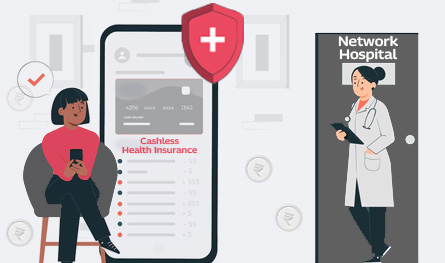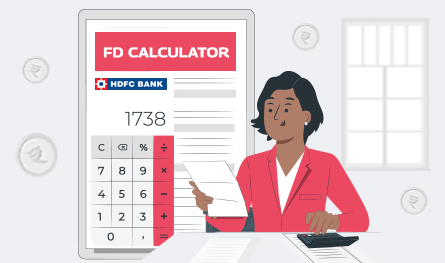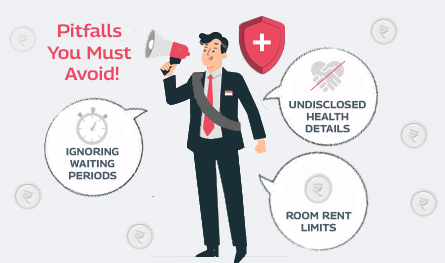How To Use Cashless Health Insurance At a Hospital?

Health is wealth, right? Medical care remains a cause of concern when money becomes an issue. Hospitals demand significant fees from patients both during emergency situations and organised medical treatments. The purpose of cashless health insurance is to serve this requirement.

The coverage enables you to maintain financial stability during medical crises without experiencing mental stress. This blog explains the meaning of cashless health insurance as well as its valuable advantages. All Paybima customers should continue reading this information. Our explanation will be basic and direct.
What’s Cashless Health Insurance anyway?
The health coverage lets you avoid making payments directly to a hospital through its network of facilities. The medical insurance firm pays treatment costs directly to the hospital. Your main responsibility centres around improving your health condition. That’s it.
Patients benefit from a convenient process where they enter a network hospital for treatment before leaving without paying with their cards or spending their savings.
Sounds lovely, no?
Why does a network hospital stand as the essential term in this arrangement?
Here’s the catch: this facility works only at a network hospital. These are hospitals that have a tie-up with your insurer.
Think of it like this. The insurance company maintains a network of hospitals that it endorses to treat its policyholders. Any hospital within their network will deal with your healthcare costs when you are admitted.
You must check the network hospital list before making any hasty visits to hospitals. Always maintain the list of network hospitals on your mobile device. The procedure can prevent future situations that lead to unnecessary disruption.
So, What’s the Process Like?
Alright. Here’s the real deal. Step by step. Under both operative cases and emergencies, these are the steps behind cashless hospitalisation procedures.
1. Planned Hospitalisation? Start Early.
When you or a member of your family requires surgery, the following steps should be taken. You already know the date. You have time. Here’s what to do:
- Review Hospital Network Participation: Confirm that the selected hospital belongs to your insurance provider’s preferred network organisations.
- Inform Your Insurer: Life Insurance policyholders need to notify their insurer about pending procedures at least 3-4 days before admission. Sometimes, even a week, if possible.
- Fill out the Pre-Authorisation Form: The Pre-Authorisation Form requires medical information combined with hospitalisation reasons as well as estimated cost details. The insurance desk at the hospital and its official website serve as sources where you can obtain this form.
- Let the Insurer Review It: The insurer evaluates all documents together with your policy while issuing their approval.
Once approved, your treatment begins. The payment is waived since you only need to show your identification documents. Showing both your health card and ID proof to the staff is all that is needed. Smooth, right?
2. Emergency Hospitalisation? Act Fast.
Emergencies are messy. Heart attacks, together with accidents and sudden medical operations, create situations where you have no time to organise anything. Even in unpredictable emergency situations, it remains possible to avail of cashless healthcare.
- Rush to a Network Hospital: A Network Hospital must be your first destination when a medical emergency arises.
- Fill the Form on the Spot: Alert hospital personnel to provide a pre-authorisation form at their present location. Fill it.
- Insurer Processes the Request: The insurer handles the request through a fast process, which takes a few hours on average. In emergencies, it’s faster.
During the period before receiving authorisation, the medical facility occasionally requires a monetary deposit from patients. Don’t panic. The approval process enables an adjustment of the security deposit.
Process to avail a Cashless Health Insurance Policy
The entire sequence of using cashless benefits starts at admission and extends through discharge in the following manner:
- At Admission: The initial step begins with hospital admission at any network facility, regardless of planned or emergency situations.
- Pre-Authorisation: The pre-authorisation process must start when you plan a treatment, since you need to send in the pre-authorisation form before treatment begins.
- Treatment Phase: Patients should maintain contact with the insurance desk throughout the treatment period. You must notify the insurance desk about every unexpected change and all unexpected medical issues.
- Discharge Settlement: Hospital staff finalise all billing expenses when patients leave the facility in the discharge process. The insurance company receives hospital bills through direct transmission from medical facilities. Once the system verifies everything correctly, your claim approval occurs instantaneously.
- Post-Discharge Claims: After hospital discharge, some medical costs may require further reimbursement to the insurance provider. The payment of additional costs at the moment is sufficient for later insurance reimbursement. A proper adherence to each instruction step results in this situation rarely occurring.
Although the process seems lengthy, it proves more convenient than filing reimbursements subsequently. You will receive quick help through the cashless facility during emergency medical situations.

Author Bio
Paybima Team
Paybima is an Indian insurance aggregator on a mission to make insurance simple for people. Paybima is the Digital arm of the already established and trusted Mahindra Insurance Brokers Ltd., a reputed name in the insurance broking industry with 21 years of experience. Paybima promises you the easy-to-access online platform to buy insurance policies, and also extend their unrelented assistance with all your policy related queries and services.
Latest Post
.jpg)
Having a bike is not just about convenience, it’s a huge responsibility. Financial protection of your two-wheeler is important and the best way to ensure that is to have a bike insurance policy that will protect you in case of an accident, theft or a natural calamity. There are so many options when it comes to policies, making it difficult to know what’s best. This guide makes it easier to choose the best bike insurance policy that is suitable for you.

.jpg)
Sometimes, we do not pay as much time and heed to car insurance policies as we do for life insurance plans. While this is quite natural, you must know that such a mistake can lead to heavy financial losses.
Even though people are now changing and more and more individuals have begun opting for car insurance, most people from the upper and lower-middle-class sections in India are not aware of why their insurance premiums vary so much.
Knowing about such variations and the factors that cause such variations won’t just educate you about premiums. It will also help you address higher premiums and tackle them effectively.


Fixed Deposits (FDs) are one of the safest ways to grow your savings. HDFC Bank offers attractive FD interest rates, allowing you to earn guaranteed returns on your investment. But before you invest, it's important to know how much interest you will earn and what your final maturity amount will be.


Health insurance plans are purchased with the hope of medical protection in times of need. However, sometimes it ends up being a source of surprise and disappointment. This mostly happens when people rush to buy health insurance plans, often overlooking essential aspects. Ignoring waiting period clauses, misunderstanding exclusions, and being unaware of sub-limits can lead to unwanted problems in the future.

.png)
In case of a medical emergency, cashless hospitalization is the best option to avail for anyone. This is only possible if your insurer has a tie-up with some hospitals that are covered under its network and where you can seek treatment without spending a penny. Here we share the list of network hospitals empaneled with Aditya Birla Health Insurance.




